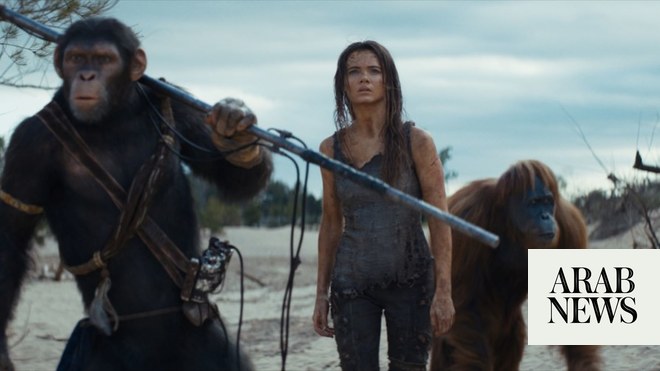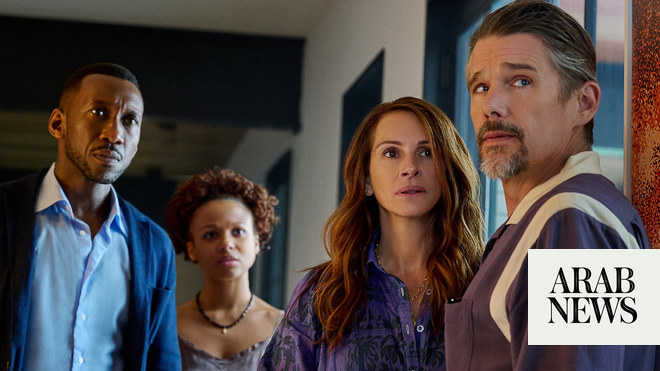
nimal cries, a howling wind, the distant calls of a flock of swans and a gurgling of buffalo at the water hole fill the length of the Duveen Galleries at Tate Britain. Heather Phillipson is at it again in her delayed 2021 Duveen commission, opening, along with the rest of the gallery, on Monday. A funfair ride to the end of the world, Rupture No 1: blowtorching the bitten peach (Phillipson’s titles are always a bit of a stretch) takes on eco-doom and nature up against it in a trashed world, ourselves, beset by pandemic, included. Her aesthetic is post-industrial, post-disaster, post-everything; part Mad Max, part video game, part excised scenes from Cormac McCarthy’s The Road, redone in glowing Technicolor. Filled with alarms, and fun for all the family, this three-part installation, her biggest work in the UK to date, is the most complex Duveen commission I’ve seen. You can’t but help let it suck you in.
To begin with, the eyes grab you. They know you’re here. A pink tongue licks an alien lizard pupil. Eye of tiger and eye of wolf, zebra eyes, swivelling chameleon eyes and bright monkey eyes, jostling and blinking and swerving on a procession of flat screens that lean this way and that, wedged into the mound of sand that runs down the middle of the gallery, each screen like a tilting tombstone. It is a kind of Noah’s ark as much as a Gulch City graveyard; there are even funnels, broadcasting the sound of a flooded world. Beached on the gallery floor, this imaginary vessel is drenched in a red glow of ambient lighting.
The colour is sumptuous and as weirdly artificial as the wildlife – screen-grabbed from nature films – which, as we progress, is inexorably supplanted by repurposed industrial wreckage. Here and there, potted plants decorate the galleries, nodding to a kind of Victorian excessiveness, their stalks drill into disused mechanical hoppers. The flower heads are papier-mache and unfurled umbrellas, their stamens aeroplane fuel tanks, like missiles aimed at the roof. Later, other projectiles are less planted than dumped, like cigarette butts in buckets of sand.
A colossal creature stands between the pillars toward the middle of the Duveen. It could be a ram, it could be a teddy bear (it is hard to tell, so far above us is the head), its huge legs forming an arch to walk through. The pulped paper body is a patchwork of tabloid headlines and pages from the pandemic: “Getting on with the jab!”, “You’ve finished Netflix so get off your bums!”, “Patients directed to … farm”, they blurt, in their shouty tabloid way.
Suddenly, a moment of calm. Beyond the ram, in the rotunda, and standing in a purplish gloom, is a pond, the watering hole for a group of shadowy creatures that remind me of Max Ernst’s Celebes, his 1921 surrealist painting.
The huge bodies of these four horned creatures that lower their heads and drink at the circular pool are wheeled, cylindrical bowsers, meant for transporting diesel, their scarred metal surfaces emblazoned with warnings about their hazardous flammable contents, and they’re lifted on legs made of old tyres. Some kind of cacky black stuff drools down them. The creatures sip delicately from the black pool, across whose surface I’m sure I saw a projected image of some other creature wallow for a second, but I could be wrong. Old bathtubs hang overhead. Are they birds? Phillipson’s Duveen project is so stuffed with details, with imagery and sculptural ideas and bits of bricolage I’m having trouble taking it all on board.
Then we’re off again. The shifting coloured light and Phillipson’s cacophonous soundscape leak from space to space. Suddenly the ram’s eyes glow a cold blue. Weird insects (fashioned from car dipsticks, roof vents and reused steel) hover in the air, along with audio speakers and weird glowing lamps. There are painted clouds on the hanging drapes that line the Duveen’s walls, and in the final space projected skies filled with unearthly light and weather race over the walls. Digitised swans migrate across the towering clouds, perhaps never to return. The gallery floor here is a kind of barren prairie, littered with crumpled silver space blankets, and a pair of turning wind-turbines (their blades replaced by anchors). At the end stands a wretched abandoned silo, a corrugated shed in which lumps of wind-blown metal clang erratically against dangling propane cylinders, like some desolate wind chime. You get the feeling the whole place could go up at any minute. Beyond even this, on the Duveen’s rear wall, a towering vertical screen depicts a sunrise over water. The sun breeches the horizon and climbs, only to give up the ghost to sink again into the sea. Wait a minute. It isn’t the sun at all, nor the moon, nor the Earth itself, but a giant peach, a wobbling fruit in an irradiated sky.
Is it the world or is it the art that’s overheated, overripe, filled with industrial dreck and fearful creatures? Like Phillipson’s The End, her whipped cream on the fourth plinth, this new work signals familiar concerns about the world’s demise, and does so with as much inventiveness and wit as sorrow and dread. Phillipson makes catastrophe entertaining, but it is a bitter fruit. Peachy, ain’t it?












